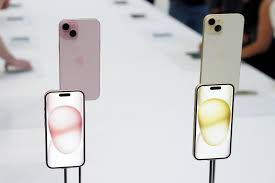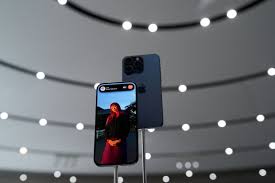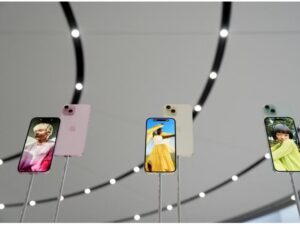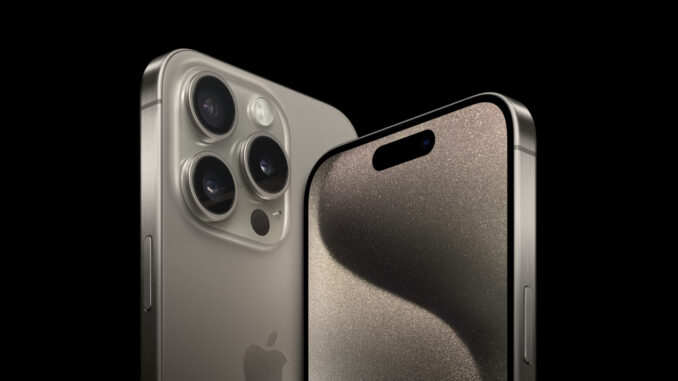
CUPERTINO, California – Apple on Tuesday unveiled a new iPhone 15 Pro with a titanium case and faster chip that enables better cameras and mobile gaming, moves designed to respond to a global smartphone slump.
The new line-up includes iPhone 15 starting at US$799 (S$1,087) and iPhone 15 Plus starting at US$899.
In Singapore, the prices of iPhone 15 and iPhone 15 Plus will start at S$1,299 and S$1,449 respectively.
Apple chose not to raise prices during a tough period globally for smartphone sales. For the Pro series, prices start at US$999 and the Pro Max at US$1,199, the same as last year for equal levels of storage, available starting Sept 22.
Both the Pro and other iPhone 15 models will have a brighter display and a 48-megapixel camera as well as 100 per cent recycled cobalt in their batteries.
Apple said the iPhone 15‘s satellite connectivity can now be used to summon roadside assistance. It is
rolling out the feature out with the American Automobile Association in the United States.
..It added that USB-C charging cables are coming to both its iPhone 15 and the charging case of its AirPods Pro devices, allowing the use of the same charging cables already used for iPads and Macs.
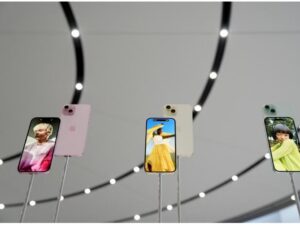
It will feature the same A16 Bionic chip inside that previously formed the brains of the iPhone 14 Pro.
The event at Apple’s Cupertino, California, headquarters comes amid lingering economic uncertainty, especially in China. The East Asian country is Apple’s third-largest market where it faces challenges from expanded restrictions on using its iPhones in government offices and the first new flagship phone in several years from Huawei Technologies.
The announcements largely met expectations and shares were down 1.7 per cent after the first hour of the event.
Apple said the iPhone 15 Pro Max – the largest phone the company makes – will have a new camera lens with a longer optical zoom than previous models. The lenses use a series of prisms to emulate the performance of a longer lens.
The new USB-C connector on iPhone 15 Pro models will allow videographers to record high-quality video directly to an external hard drive, making it easier to use the phone as a professional video camera, Apple added.
It also said the iPhone 15 Pro can capture what it calls “spatial videos” by using two of the device’s cameras to capture a three-dimensional video.
Those videos will be viewable on Apple’s Vision Pro headset that is due out early in 2024, said senior vice-president of worldwide marketing Greg Joswiak.
An executive said the company used machine learning to detect a person in the frame, allowing users to turn a picture into a portrait immediately or later in the Photos app.
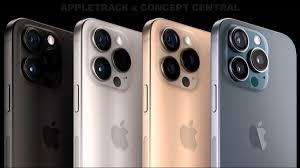
Apple also showed off a new Series 9 Watch with a feature called “double tap” where users tap thumb and finger together twice, without touching the watch, to perform tasks such as answering a phone call.
It uses machine learning to detect tiny changes in blood flow when the user taps their fingers together, freeing up the other hand for other tasks like walking a dog or holding a cup of coffee, said Apple chief operating officer Jeff Williams.
The Watch Ultra 2 has new features for cycling and diving and what Apple said is the brightest screen it has ever made.
The Series 9 will start at US$399 and the Ultra 2 watch will start at US$799 and be available from Sept 22.
Apple will no longer use leather in any of its products, said Ms Lisa Jackson, the company’s vice-president of environment, policy and social initiatives.
The company is replacing some of those products with a textile called FineWoven that reportedly feels like suede.
Chief executive Tim Cook also said Apple is “on track” to ship its Vision Pro mixed-reality headset early in 2024.
While Apple is introducing new features and products, the iPhone made up more than half of the company’s US$394.3 billion in 2022 sales.
The global smartphone market has slumped from shipping 294.5 million total phones to 268 million in the second quarter, but Apple’s shipments declined the least of any major smartphone maker, dropping from 46.5 million phones to 45.3 million, according to data from Counterpoint Research.
“The truth of the matter is, we’re in a very down smartphone market,” said Mr Bob O’Donnell, head of TECHnalysis Research. REUTERS
